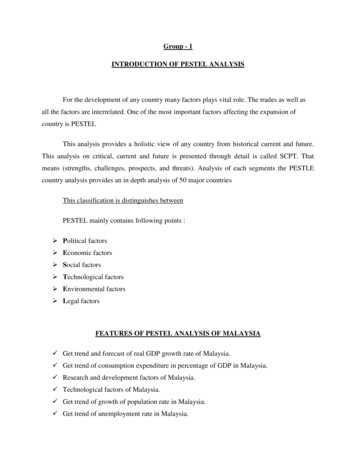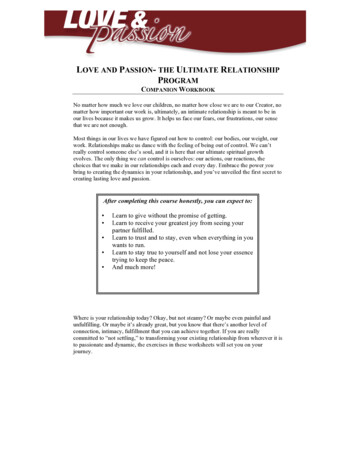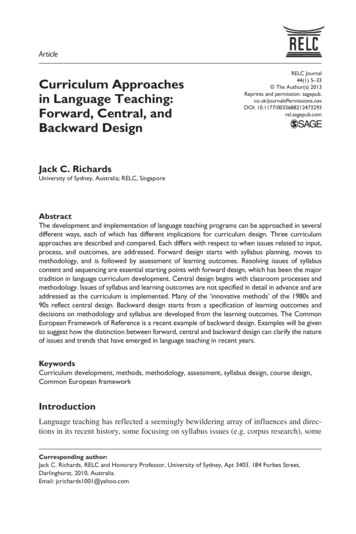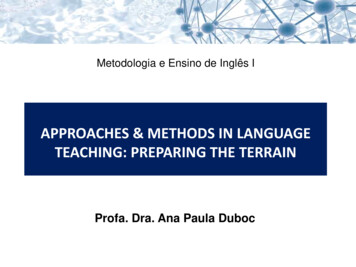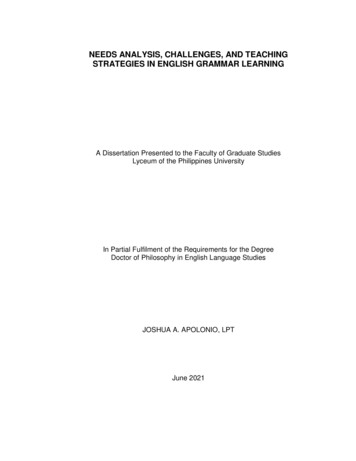
Transcription
NEEDS ANALYSIS, CHALLENGES, AND TEACHINGSTRATEGIES IN ENGLISH GRAMMAR LEARNINGA Dissertation Presented to the Faculty of Graduate StudiesLyceum of the Philippines UniversityIn Partial Fulfilment of the Requirements for the DegreeDoctor of Philosophy in English Language StudiesJOSHUA A. APOLONIO, LPTJune 2021
Lyceum of the Philippines University Graduate SchoolpageAPPROVAL SHEETIn partial fulfillment of the requirements for the degree Doctor ofPhilosophy in English Language Studies, this dissertation entitled “NeedsAnalysis, Challenges, and Teaching Strategies in English Grammar Learning”has been prepared by Joshua A. Apolonio, LPT, for acceptance and approval.Imelda L. An, Ph DResearch AdviserApproved by the Panel of Examiners with a grade of .PANEL OF EXAMINERSReynalda B. Garcia, EdD, DPA, Ph DChairmanArnie Christian D. Villena, Ph DMemberEleonor C. Magadia, Ph DMemberChona D. Andal, Ph DMemberBeverly T. Caiga, LPT, Ph DMemberDate of Comprehensive Exam with a final grade ofAccepted and approved in partial fulfilment of the requirements for theDegree Doctor of Philosophy in English Language Studies.Arnie Christian D. Villena, Ph DProgram Deanii
Lyceum of the Philippines University Graduate SchoolpageABSTRACTTitle:Needs Analysis, Challenges, and TeachingStrategies in English Grammar LearningAuthor:Mr. Joshua A. Apolonio, LPTDegree:Doctor of Philosophy in English LanguageStudiesDate of Completion:June 2021Thesis Adviser:Dr. Imelda L. AnThis study employed a descriptive-correlational approach to assessingthe students’ needs, grammatical challenges, and teachers’ preferred teachingstrategies. Correlational analysis was utilized to treat data concerning theteachers’ preferences regarding needs analysis and teaching strategies. Anindependent sample T-test was used to identify the difference in the teachers’responses on determining the respondents’ perception about the needsassessment used for Junior and Senior High school students and therelationships between the perceived grammatical skills of English teachers.Findings revealed that the teachers’ grammar needs analysis onspeaking skill was classified as the most critical assessment, while the leastessential was the viewing skill. English teachers agreed that the usual Englishgrammar challenge is when they expect the teachers to present grammarpoints explicitly. However, they disagree that they do not find grammaticalterminologies useful. Reading was the regularly used teaching approach iniii
Lyceum of the Philippines University Graduate Schoolpagegrammar, whereas the less-used was the speaking strategy. Moreover, asignificant difference occurred between the grammar skills and needs analysisused when grouped according to grade levels. Senior high school teachershad greater assessments on teaching grammar through vocabulary, speaking,and writing.Furthermore, senior high school teachers considered grammar needson speaking and writing as more important. There was no significantrelationship between teaching strategies, and grammar needs to the students’English grammatical challenges. Therefore, a strategy enhancement programfor both the Junior and Senior high school levels has been proposed.Keywords: grammar, needs assessment, challenges in grammar learning,teaching strategies, macro skills, strategy enhancement program, secondaryteaching, junior and senior high school grammar, K-12 English curriculumiv
Lyceum of the Philippines University Graduate SchoolpageACKNOWLEDGMENTThe researcher’s grateful and heartfelt acknowledgments are given toall of the faculty members, classmates, and friends who had kept on supportinghim all throughout the completion of this dissertation. In the same way, hewould like to express his gratitude to the following:To the Lyceum of the Philippines University – Graduate School family,together with the Divine Word College of Calapan community, for guiding himtowards the right direction and by providing him the quality education that heneeds;To his endearing co-teachers in the DWCC Senior High schooldepartment, together with the Principal, Dr. Fedeliza A. Nambatac, andDirector, Bro. Hubertus Guru, SVD, who all inspired him on pursuing his questfor teaching;To his adviser, Dr. Imelda L. An, for giving him sound and valuableinsights in English language and research, and to the panel chair and itsmembers Dr. Reynalda B. Garcia, Dr. Arnie Christian D. Villena, Dr. EleonorC. Magadia, Dr. Chona D. Andal, and Dr. Beverly T. Caiga, for their substantialcomments and suggestions for the improvement of this work;To his family, including his mother, sisters, cousins, and nephews, theHoly Child family, Fr. Raphael Gomes, SVD and Fr. Richard Rodriguez, fortheir continuous support, prayers, and endless encouragement towards thesuccess of his lifelong education, teaching career, and his Ph. D. journey;v
Lyceum of the Philippines University Graduate SchoolpageFinally, the researcher’s wholehearted gratitude is given to the AlmightyGod through the undying intercession of the Blessed Mother. Without Him, thisresearch will not be possible.vi
Lyceum of the Philippines University Graduate SchoolpageDEDICATIONThis work is dedicated to my loving parents, Engr. Nemesio P. Apolonio, Jr. and Engr. Caridad J. Asinas, whose words of encouragement and push forgreat achievements are overwhelming, to my family and friends, co-teachers,students, and to my brothers and sisters in Christ, who stoodby me and inspired me in this Ph. D. journey. I will alwaysappreciate all you have done, especially the personwho has helped me make all of these possible.Ad Majorem Dei Gloriam!vii
Lyceum of the Philippines University Graduate SchoolpageTABLE OF CONTENTSTitlePageTitle PageiApproval e of ContentsviiiList of Figure/ TablesixList of AppendicesxIntroduction1Objectives of the Study7Review of Related Literature8Methods47Research Design47Participants48Instruments Used48Research Procedures50Data Analysis51Ethical Considerations51Results and nces166Appendices186viii
Lyceum of the Philippines University Graduate SchoolpageLIST OF FIGURE / TABLESFigureTitlePage1Map showing the Locale of the Study Area inCalapan City, Oriental Mindoro9Table No.TitlePage1Grammar Needs Analysis through Listening522Grammar Needs Analysis through Speaking583Grammar Needs Analysis through Reading664Grammar Needs Analysis through Writing755Grammar Needs Analysis through Viewing846Summary Table on the Need Analysis897Challenges in English Grammar Learning928Teaching Grammar Strategies in Listening1039Teaching Grammar Strategies in Vocabulary11310Teaching Grammar Strategies in Speaking12211Teaching Grammar Strategies in Reading13112Teaching Grammar Strategies in Writing14013Summary Table on the Teaching GrammarStrategies14814Difference of Responses on Teaching Grammarbetween the two groups of Respondents15015Difference of Responses on Grammar NeedsAnalysis between the two groups ofRespondents15216Relationship between Teaching Grammar,Grammar Needs Analysis, and Challenges inEnglish Grammar Learning15417Strategy Enhancement Program for SecondaryEnglish Language Teachers156ix
Lyceum of the Philippines University Graduate SchoolpageLIST OF APPENDICESAppendicesTitlePageATeaching Strategies, Needs Analysis, andChallenges in English Grammar LearningQuestionnaire186BLetter to the Schools DivisionSuperintendent, Division of Oriental Mindoro193CLetter to the Private and Public School Heads195DLetter to the Respondent196EDepartment of Education Endorsement Letterfor Public Schools197FStatistical Output198GCurriculum Vitae of the Researcher229x
Lyceum of the Philippines University Graduate SchoolpageINTRODUCTIONThe English language has already been a part of the naturalcommunication between the teachers and the learners. More so, Englishteachers' grammatical skills serve as the basis of the students' languageimprovement. Teachers enable the students' language capabilities to progressand intensify them as they communicate in various professional settings.Nugraheni (2017) stated that teachers also acquire advantages throughdifferent teaching strategies and approaches as they teach grammar. In thisway, the teachers also receive the language as they learn where their onlytarget is to teach the language.Moreover, an English teacher must learn to decide the best strategy touse when teaching grammar, utilizing an equilibrium between learninggrammar and natural communication (Nugraheni, 2017). On the other hand,grammar has not been the highlight in learning since teaching English focusesprimarily on the Genre-Based Approach (GBA). In this way, grammar becomesa part that strengthens the genre of what the teacher explains.For that reason, grammar teaching is not taught separately. Englishinstructors may use various teaching strategies to explain English grammarextensively. It aims to let the students enjoy and clearly understand what theteacher explains in the class. Though grammar may not highlight teaching theEnglish language, grammar is necessary to achieve the language acquisitionobjectives, suggesting that the students must create a written or oral genre1
Lyceum of the Philippines University Graduate Schoolpagetext. The learners must have a mastery of the grammatical application indifferent contexts to develop their grammatical abilities for future application.On the other hand, needs analysis serves as the foundation of theEnglish language's different applications for specific purposes. The purpose ofassessing the students' needs is to determine how English grammar is beingdeveloped in the language classroom, either through reading or writing. Asproved by Brown (1995) in Cunningham (2016), needs assessment aims toorganize all essential subjective and objective information needed tostrengthen the language curriculum to fulfill the students' language learningobjectives in various educational settings and the teaching-learning pedagogy.In summary, needs assessment provides the pedagogical analysis of allrequired educational information for strengthening a language curriculum.However, the students' language learning skills highlight the listening,speaking, reading, and writing skills that are being categorized and measuredthrough their grammar. Besides, these skills hold equal worth, supporting eachother from learning the listening skill to speaking and learning to read to writing.A learner can be identified to have a trained language competency when thesefour interpersonal capabilities are combined. The teacher plans the bestinstruction following how the students will learn these language capabilitiesidentified in the language classroom. Teachers assess the students' needsbased on their knowledge and understanding, either formally or informally(Linde, 2018). A needs assessment can be applied through formative tests to2
Lyceum of the Philippines University Graduate Schoolpagelet the teachers determine how their students excel on these skills. Needsanalysis through formal reviews enables the teachers to measure the students'working level and understand their performance in class through tests or quiz.Consequently, informal assessments are used to guide instruction. In this way,the teacher deals more with observing the learner if (s)he struggles in the classwhere there are no quizzes given but the teacher guides and watches thestudent at work.As Linde (2018) explains, determining how students excel in the classis substantial to identify how they develop in language learning. As they gainthe macro skills through the language learning-acquisition process, they mayalso adopt the necessary skills suitable for their needs. It suggests that everystudent learns following how the teacher assesses their needs.The relevance of including grammar in the English pedagogy has beenargued by different scholars where they recommend that grammar educationmust not diminish the importance of language learning. However, it showedthat a set of standards must identify the various communication parts that maybe applied as something that can be quickly done right away. The relevanceof English grammar teaching applies to the students' needs in languagelearning and enhancement.As students continually progress applying language learning throughoral and written communication, students can advance their communicativecompetencies and complexity in terms of grammar application and word3
Lyceum of the Philippines University Graduate Schoolpagechoices. Students tend to determine necessary language usage in varioussituations that comprise both academic and professional competencies. Thelearners' language capabilities primarily deal with how they focus on theeducational setting that requires language learning in their curriculum.Moreover, students learn to understand spoken or written languagethrough various genres applied in different contexts. Language teaching andlearning are prioritized in additional strategies that can be used throughsymbols, grammar, vocabulary, and communicative competencies. Thelanguage learners are given opportunities to apply both oral and writtencommunication that uses words and structures that deal primarily with theirmacro skills (Bloome, 2020).Nevertheless, challenges in English grammar learning indicate thevarious difficulties being faced by persons involved in the educational setting,both teachers and students. These student-experienced challenges aremanifested in the various macro skills application that can be seen primarily intheir fears and unwillingness to use the English language, which results in aninsufficient vocabulary, poor language acquisition, and a low rate of syntacticalknowledge, most notably the subject-verb agreement rules.One of the main problems in English grammar learning is the unqualifiedteachers that can be seen as the most unnoticed difficulty in the classroom.This challenge becomes more difficult to solve because various schoolscomprise English language learners. They cannot quickly identify who is the4
Lyceum of the Philippines University Graduate Schoolpagebest English language teacher and who is least. In this way, the learnerscommonly take whatever the English teacher explains, whether correct or not.As Ama (2019) proves, second language learning and acquisition have playeda challenging role in the classroom, specifically grammar. This difficulty ishighly evident when a country is not using English as its mother tongue. Forexample, English language learners here in the Philippines experience variouschallenges since English is not their native tongue.Another problem encountered in the classroom is that the learnerscommonly see that the same English language register used on the streets orat their homes is the same register they apply in the school, most notablyduring the examinations or recitations. Since communication does not serveas a basis for the students’ intelligibility, they do not depend much greatly onthe grammatical rules taught to them by their English teacher and therefore donot entirely learn the English language (Ama, 2019).On the other hand, language teaching and learning are the mainhighlights in educational pedagogy. According to Mousena and Sidiropoulou(2017), the learners are observed through their language competencies thatapply the relationship between the teaching-learning process and how theyinteract through language development. As the students continuouslyprogress, language development is determined through its significancefollowing its application in different purposes and competencies. The learnerscan develop themselves in various educational settings and language5
Lyceum of the Philippines University Graduate Schoolpagecapabilities highlighted as a fully developed learning motivation.Also, students can identify how they learn to recognize diction that languagecompetencies and capabilities are enhanced, and the students can developthemselves through skills improvement, such as the way they pronouncecorrectly apply grammar in different genres. Moreover, Duff and Tomblin(2018) say that the student's needs are assessed by the teachers in othereducational applications and evaluated through their performance andcapabilities.Specifically, this paper aims to prove that the grammatical skills and theJunior and Senior high school English language teachers' needs assessmentemphasize the students' language capabilities. This paper sought tostrengthen language research and information technology as an adequatefoundation for students' awareness of the English language's vital role invarious education parts. This paper also serves as a helpful springboard,explaining and rationalizing that English teachers' strategic grammar skills andassessing their needs are necessary. Being a Doctor of Philosophy in EnglishLanguage Studies candidate, the researcher has the pivotal role andcommitment to achieve the paper's objective.Hence, the study concentrates on both the Junior and Senior HighSchool English language students' grammatical skills to determine theteaching strategies concerning English grammar learning. Also, it aims to6
Lyceum of the Philippines University Graduate Schoolpagecategorize the needs analysis of English teachers in the students' grammarlearning. It enables people to identify their challenges in the students' Englishgrammatical skills as part of their language capabilities and their needsassessment towards the students among the selected Junior and Senior HighPublic Schools of Calapan City, Oriental Mindoro.OBJECTIVES OF THE STUDYThis paper assessed the achievements or mastery of English teachers’language capabilities when specific grammar skills and needs assessmentsare used.More specifically, the paper pursued to achieve the following objectives,which are to determine the level of importance of English teacher’s needsanalysis in the students’ grammar learning, to assess the challengescommonly experienced by the students in grammar learning based on theteachers’ strategies, and to identify the teaching strategies concerning theEnglish grammar learning in the Junior High school and Senior High schoollevels. Additionally, it also targets to test the significant difference in thegrammar skills and the needs analysis used when grouped according to gradelevels, to test the significant relationship of the teachers’ needs analysis,challenges experienced in grammar learning, and the teaching strategies usedin the classroom, and finally, to propose a teaching strategy enhancementprogram for grammar.7
Lyceum of the Philippines University Graduate SchoolpageREVIEW OF RELATED LITERATUREResearch LocaleThe researcher investigated the different public and private junior andsenior high schools in Calapan City, Oriental Mindoro, currently managed bythe Department of Education in the Schools Division of Calapan City. Thesepublic and private high schools comprise the English teachers under the JuniorHigh School (Grade 7-10) and Senior High School (Grade 11-12). TheDepartment of Education aims to develop the students’ English language skills,most notably in grammar, utilizing the spiral curriculum that targets thecontinuous growth of grammatical competencies starting from Junior highschool through their listening, speaking, reading, and writing skills until theyfinish the senior high school before going to college.The selected public and private schools in different barangays arelocated in Calapan City, Oriental Mindoro, spearheaded and managed by theDepartment of Education – Division of Calapan City. The Schools DivisionSuperintendent supervises all teaching-learning activities, including theadequacy of quality education through a student-centered teaching strategy,outdoor classes (e.g., seminars/ workshops), and the student needsassessment. Inclined with the implemented Enhanced Basic EducationCurriculum, DepEd-Calapan City recognizes the outstanding studentperformances and their achievements in different areas such as academics,social-responsibility and leadership, and other fields that highlight their8
Lyceum of the Philippines University Graduate Schoolpageprogress and enhancement. These awards encourage the students to reachan excellent outcome and practice a proactive membership inside and outsidethe school.Figure 1. Map showing the locale of the study area inCalapan City, Oriental MindoroHowever, as teachers apply the spiral approach, DepEd offered Englishlanguage subjects from simple to complex under the K-12 curriculum, startingfrom Junior High School (Grades 7-10) using the basic English grammar andparts of speech until they entirely apply them in the Senior High School(Grades 11-12) through oral communication or by using English in academicand professional purposes. In addition, teachers, as facilitators, apply studentcentered learning that encompasses teaching methodologies that transfers the9
Lyceum of the Philippines University Graduate Schoolpagefocal point of instruction from the teacher to its learners. This learning approachis highly evident to let the learners apply independent learning, metacognition,and output-based instruction. In Junior high school, one (1) English subject isbeing taught for each grade level that comprises consistent topics turning to amore complex one, highlighting the students’ development in readingcomprehension, listening, vocabulary, literature, writing, composition, orallanguage, fluency, and grammar awareness. Junior High school teachersassess English for 160 hours for two consecutive semesters. On the otherhand, the Senior high school provides two (2) English subjects, including acore subject of Oral Communication in Context and an applied subject ofEnglish in Academic and Professional Purposes, which the instructor teachesfor 80 hours per semester.Needs AnalysisAccording to Kahng (2015), needs assessment is applied through athorough analysis of language and communication. Teachers assess thestudents’ needs in the educational setting that highlights their learningobjectives, including the cognitive, affective, and psychomotor domains. Thesedomains affect the students’ learning variables that would fulfill their needs,including their competencies and awareness in the classroom setting.Additionally, a successful needs analysis balances an organized set ofcurriculum products that satisfy the students’ language learning requirements.In this way, the students’ needs assessment reflects the whole educational10
Lyceum of the Philippines University Graduate Schoolpageinstitution in different situations, particularly in the curriculum. Therefore, itsuggests that the student’s needs must prioritize the learning objectives toassess their language teaching-learning process needs.Additionally, it has been suggested that assessing the students’ needsfollows a methodical process including basic decision making, data gathering,and information application (Brown, 1995 as cited in Kahng, 2015). As theteachers learn to analyze the students’ needs, they can organize things bydetermining the students’ point of view, acquiring knowledge simultaneously,and learning what students apply as they participate.As proved by Otilia (2015), the students’ needs are evaluated to supportthe teachers in assessing their learners’ language development in grammarskills, including the challenges they experience being applied in differentlinguistic disciplines. As the teacher determines the learners’ needs andcreates motivation for the learning objectives, the application of resourceswould be chosen depending on their capabilities. In this way, analyzing thestudents’ needs serves as the foundation for how the curriculum’s learningcompetencies, teaching resources, and strategies are applied and formulated.Applying them through needs analysis enhances the learners’ motivation andaccomplishments in the end.Also, Chen, et al. (2016) explain that one of the objectives of needsanalysis is to examine the learners’ perception and assess them on languageacquisition and application in various contexts in different settings and11
Lyceum of the Philippines University Graduate Schoolpagesituations. More predominantly, analyzing the learners’ needs intensify theirlanguage learning and skills in a particular context. Research emphasizes theessential function of needs analysis in grammatical approaches and coursedesigns. Needs analysis aims at assessing the English grammar class wherethe learners necessitate. It can help the students identify their abilities inknowing, doing, and learning. Therefore, analyzing the students’ needs isessential and generally perceived as a fundamental part of grammar learning.Equally important, Albassri (2016) explained that needs assessmentserves as the primary foundation in the language teaching-learning process.The students much depend on how the teacher will manage the Englishlanguage class. It emphasizes that needs assessment provides tremendousimportance in the educational setting, most especially to the learners’ needs(Shahriari & Behjat, 2014 as cited in Albassri, 2016). Moreover, assessing thestudents’ needs aims to determine how they have developed and fulfill theirobjectives. As the teacher applies what is necessary for the curriculum, thestudent’s needs must be related and matched according to the subject matter.Once these needs are identified through the lesson plan’s goals andobjectives, it may now serve as the teacher’s basis for evaluating the students’development through tests, activities, materials, and others. In this manner, theteacher will therefore assess the students’ needs through proper assessment.In light of Shahriari and Behjat (2014) in Albassri (2016), needsassessment emphasizes how the curriculum is being applied to the students.12
Lyceum of the Philippines University Graduate SchoolpageTherefore, the students’ analysis and their level of competence go hand-inhand in the curriculum process. Henceforth, the students’ needs serve as thebasis when starting a curriculum. The needs assessment of the studentsserves as the foundation of a curriculum design framework. More so, a needsassessment must be the starting point of a language curriculum. In this way,the language program may be reexamined and reevaluated according to thecurriculum objectives (Iwai, et al., 1999 as cited in Albassri, 2016).Similarly, needs analysis is a fundamental requirement that includes theschool’s stakeholders, including the parents, teachers, and the learners. Onthe other hand, the conflict becomes evident when the needs are not beingapplied to all the community members involved in the classroom. Therefore,these needs must be well identified, analyzed, and investigated because thecurriculum must incline and support the community’s selected members andthe others involved in the learning process. Moreover, language learning isapplied in the communicative and sociocultural pedagogies that are evidentinside a particular educational field (Belcher, 2006 as cited in Albassri, 2016).According to Mead (2015), analyzing the needs of oral communicationskills applies a particular assessment method. However, the method appliedfor providing feedback to the newly skilled learners is not necessary on studentevaluation per quarter. On the other hand, all assessment tools to be used forneeds analysis must follow the measurement principles regarding its validity,reliability, and fairness at all costs. An accurate and consistent instrument must13
Lyceum of the Philippines University Graduate Schoolpagebe observed for it will represent all the skills to be measured, and it must controlsimilarly with an enormous number of students.Moreover, determining the suitable instrument to be utilized depends onits purpose for the needs analysis and its availability. If its goal is to analyzethe needs of a specific set of grammatical competencies, for instance,diagnosing the strengths and limitations or analyzing the mastery of a goal, thetest must be according to the competencies. If the practice tests are notobtainable, the instrument to be used must be well designed to determine andachieve the students’ needs. If it targets to generally assess communicationthrough grammar, such as a new program evaluation or district goalsassessment, the needs must be measured from time to time and, if possible,the progress must be described through external norms, either national orstate. Meaning, it is necessary to observe an appropriate test that undergoesthorough progress, validation, and reliability, even if the test does not fullymatch the local program (Mead, 2015).Also, Shank (2016) stated that the students’ needs and capabilitiesassessed by the teachers became a fundamental part of their lives. Moreover,the teachers must provide various teaching strategies and assessment toolsto help them fulfill their educational needs and reach their future profession.Being one of the primary sources of knowledge, the teachers have toassess their learners’ capabilities and excel in the classroom. Furthermore, theteachers must identify and meet their students’ needs and reach their14
Lyceum of the Philippines University Graduate Schoolpageexpectations by learning objectives. In this manner, the teacher must learn howhis /her students can adapt to the classroom environment and how it will bepossible to everyone (Shank, 2016).Correspondingly, the students’ literacy needs assessment is necessaryfor classroom instruction. Based on the Center for Applied Linguistics (2016),the students can reach the standards of using English as a Second Language(ESL) in various motives such as they want to learn English for communicationpurposes or learn it for their future endeavors. However, if these needs werenot achieved and the learning objectives were not met, it would affect them.T
Findings revealed that the teachers’ grammar needs analysis on speaking skill was classified as the most critical assessment, while the least essential was the viewing skill. English teachers agreed that the usual English grammar challenge is when they




